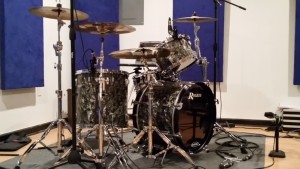Finding Your Room’s Sweet Spot for Recording Drums

An all-important detail that isn’t mentioned in many articles about recording acoustic drums is how important it is to find the “sweet spot” in your room where the drums sound their best. I found this out the hard way. Since building my studio several years back, I’ve always set up the drums roughly centered along one of the longer walls (my room is 24′ x 22′), with the drummer’s back to the wall. This just seemed to be the logical place to set them up. It allowed me plenty of room to work around the kit when setting up the mics, allowed good visual communication between the drummer and the other band members, and it kept the kit somewhat out of the way for when people walk through the live room to the control room (which is on the opposite end of the building from the front door). It also allowed my own band plenty of room to set up a guitar amp on one side of the kit and a bass amp on the other for rehearsals, since that’s how things would normally be set up on stage during a live performance.
Then, a few months ago I was working on restoring an early 1970’s vintage Rogers Powertone drumkit that I’ve owned since I was in junior high school. When I was finished with the restoration project, I tried to make some space wherever I could to set them up and try them out. When I started playing those drums, I was floored. They sounded thunderous (specifically the kick drum and toms), and better to my ears than just about any other kit I’ve recorded in my studio. They sounded so good, I almost couldn’t stop playing them! Another surprising detail was that the kick drum was only a 20″ x 14″! That’s considerably smaller than most modern kick drums, which are often 22″ x 18″, so you wouldn’t expect to get such a huge sound out of it.
After playing those drums for a while where they sat, I decided to move my newer drum kit out of the way, and set up the vintage kit in its place to try recording it. To my surprise, the vintage kit just didn’t sound as good there as it did in the other location! It sounded a bit flat, and that massive low end I had been hearing from the kick and toms simply wasn’t there like before. In effect, I had accidentally discovered the “sweet spot” where the drums sound their best in my room. That sweet spot ended up being with the drummer’s back against a different (shorter) wall, off-center, with the kit slightly nearer to one of the corners. I also discovered that I could set up my other kit in the same location on the opposite wall (imagine a mirror image of the room), and they also sounded better there than in the old location (although they still don’t sound as good as the vintage Rogers kit–those drums are just sweet!).
This was a major revelation for me. I’ve spent numerous hours and dollars over the years upgrading my mics, preamps, processors, tweaking mic positions, and trying different heads and tunings to try and improve my recorded drum sounds. I know those changes made a difference, none of them were as dramatic as simply moving the kit to another location within the room. Not to mention this added benefit: it just feels better and you’re more inspired to play when your kit sounds as good as it can in your room.
If you haven’t identified your sweet spot yet, here’s my advice to find it:
1. Clean out your tracking room as much as possible.
2. Set up your kick, floor tom, and snare drum on a rug.
3. Assuming your floor isn’t carpeted, you can gently drag the rug to different locations around the room and bang on the drums for a few minutes. When moving the kit, try moving it just one or two feet in any given direction. You’ll be surprised at how different things can sound, even when the change of position doesn’t seem too drastic.
4. Take some notes about the sound of the drums at each location.
5. Repeat steps 3 and 4 until you’ve tried pretty much every location for the kit in the room.
It won’t take long until you find one spot in the room that sounds better than the others. When you do, that’s your sweet spot. Make this the permanent location for setting up the drums, if possible. Set your kit up there, mic them up, and start rolling.
Please note that this article assumes that your room already has generally decent acoustics and has been treated with acoustic panels, foam, or blankets to help with any major problems. If your whole room sounds bad to begin with (too live or too dead), moving the drums around within the room may not make much of a difference.
 July 25, 2017
|
Posted by Jon (admin)
July 25, 2017
|
Posted by Jon (admin)

 Categories:
Categories:  Tags:
Tags: 